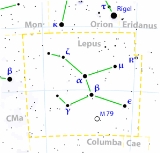
R Leporis
Encyclopedia
R Leporis (R Lep), sometimes called Hind's Crimson Star, is a well-known variable star
in the constellation Lepus
, near its border with Eridanus
. It is designated "R" in the chart to the right.
It is a carbon star
which appears distinctly red. It is named after famous British astronomer J. R. Hind
, who observed it in 1845. Its apparent magnitude
varies from +5.5 to +11.7 with a period of 418–441 days, although recent measurements give a period of 427.07 days. There may be a secondary period of 40 years.
R Leporis has often been reported as an intense smoky red color, although this is not pronounced when the star is near its maximum brightness. It is reddest when it is dimmest, which occurs every 14.5 months. During these periods it is a candidate for the most-visible reddest star, but this claim is questionable. The red coloration may be caused by carbon in the star's outer atmosphere filtering out the blue part of its visible light spectrum
. The star's discoverer, Hind, reported that it appeared "like a drop of blood on a black field."
Variable star
A star is classified as variable if its apparent magnitude as seen from Earth changes over time, whether the changes are due to variations in the star's actual luminosity, or to variations in the amount of the star's light that is blocked from reaching Earth...
in the constellation Lepus
Lepus (constellation)
Lepus is a constellation lying just south of the celestial equator, immediately south of Orion. Its name is Latin for hare. Although the hare does not represent any particular figure in Greek mythology, Lepus was one of the 48 constellations listed by the 2nd century astronomer Ptolemy, and it...
, near its border with Eridanus
Eridanus (constellation)
Eridanus is a constellation. It is represented as a river; its name is the Ancient Greek name for the Po River. It was one of the 48 constellations listed by the 2nd century astronomer Ptolemy, and it remains one of the 88 modern constellations. It is the sixth largest of the modern...
. It is designated "R" in the chart to the right.
It is a carbon star
Carbon star
A carbon star is a late-type star similar to a red giant whose atmosphere contains more carbon than oxygen; the two elements combine in the upper layers of the star, forming carbon monoxide, which consumes all the oxygen in the atmosphere, leaving carbon atoms free to form other carbon compounds,...
which appears distinctly red. It is named after famous British astronomer J. R. Hind
John Russell Hind
John Russell Hind FRS was an English astronomer.- Life and work :John Russell Hind was born in 1823 in Nottingham, the son of lace manufacturer John Hind, and was educated at Nottingham High School...
, who observed it in 1845. Its apparent magnitude
Apparent magnitude
The apparent magnitude of a celestial body is a measure of its brightness as seen by an observer on Earth, adjusted to the value it would have in the absence of the atmosphere...
varies from +5.5 to +11.7 with a period of 418–441 days, although recent measurements give a period of 427.07 days. There may be a secondary period of 40 years.
R Leporis has often been reported as an intense smoky red color, although this is not pronounced when the star is near its maximum brightness. It is reddest when it is dimmest, which occurs every 14.5 months. During these periods it is a candidate for the most-visible reddest star, but this claim is questionable. The red coloration may be caused by carbon in the star's outer atmosphere filtering out the blue part of its visible light spectrum
Spectrum
A spectrum is a condition that is not limited to a specific set of values but can vary infinitely within a continuum. The word saw its first scientific use within the field of optics to describe the rainbow of colors in visible light when separated using a prism; it has since been applied by...
. The star's discoverer, Hind, reported that it appeared "like a drop of blood on a black field."

